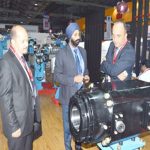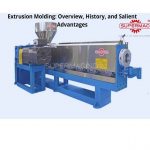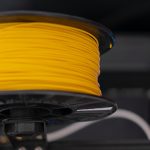The extrusion process that takes place on extrusion machines is essential to contemporary wire and cable production, transforming raw materials into important components of our well-connected world. This complex process of mechanical accuracy and material science turns raw materials into compelling wires and cables. Extrusion starts with the careful selection of polymers, usually polyethylene or polyvinyl chloride that fulfills electrical insulation and sheathing criteria. A precise pre-treatment process removes moisture from these polymers in a hopper, maintaining product integrity. The granules enter the extruder barrel, a heated chamber that transforms them.
Raw material contacts auger-like screws in the extruder provided by the top extruder manufacturers. Smooth screws and barrel-wrapped heaters create frictional heat. The material melts into a homogenous, viscous mass as it passes through the screws under increasing temperatures and shear stresses. This molten polymer, now a potential conduit, is ready to transform. Extrusion involves forcing molten material through a die. An engineering masterpiece, the die forms the polymer to its ideal contour. The die extrudes a cylindrical tube to insulate the conductive core in wire and cable manufacturing. Micrometrically controlling this extruded layer’s size and properties ensures consistency in the desired industry requirements.
Extruded polymer encases the conductor as it emerges from the die, depending on whether the result is a single wire or a multi-core cable. A water bath or air chilling procedure solidifies the polymer and locks in its structural integrity on the freshly coated wire or cable. Advanced sensors and control systems monitor the extrusion process to make sure every inch of wire or cable meets stringent standards. The outcome is a device that satisfies the highest electrical performance and durability criteria and exemplifies technical elegance. The extrusion process in wire and cable manufacture combines art and science, combining material behavior, mechanical accuracy, and thermal dynamics to generate contemporary civilization’s lifelines.
Understanding the Extruder: The pinnacle of mechanical and thermal engineering
Produced by the top extruder machine manufacturer in India, an extruder, a contemporary technical wonder, carries out material processing transition. This machine blends raw materials and precise mechanics to generate a constant stream of high-quality goods. This complex system, with moving screws and heated chambers, is the pinnacle of mechanical and thermal engineering. An extruder’s barrel and screw(s) generate a dynamic environment for melting, mixing, and shaping raw materials. As solid grains or powders enter the funnel-like hopper on top of the barrel, transformation occurs. Here, the raw material descends into the extruder’s core with controlled chaos and scientific precision. The screw, a helical, auger-like device that drives extrusion, turns as the material enters the barrel. Optimizing the melting and mixing of material by using screw pitch, depth, and other configurations is an art. The screw moves the material forward, creating frictional heat that melts the solid granules into a viscous, uniform molten mass using external heaters in the barrel. A carefully controlled temperature and pressure increase through the barrel to prepare the material for extrusion. A die, a custom-designed opening, forces this molten polymer into the appropriate form. The die is the extruder’s maestro, shaping molten polymer into delicate filaments or strong cables.
After the die, the extruded material uses a cooling system to solidify the work-piece, retaining its shape and durability. Cooling in water or air locks in the material’s characteristics makes it suitable for processing or usage. A complex array of sensors and control systems precisely monitors temperature, pressure, and material flow in the extruder. These systems optimize extruder settings to provide consistent, high-quality output that satisfies industrial requirements. Most extrusion line manufacturers in India enlighten their customers regarding the optimal settings of the extruders.
All in all, an extruder is more than a machine—it’s a symbol of technical harmony, where heat, pressure, and mechanical motion generate creativity. It is a symbol of industrial prowess, a technology that makes the ordinary exceptional, and a cornerstone of contemporary industry.
XLPE Extrusion and Sioplas Extrusion Machine
Modern engineering turns basic ingredients into strong, high-performance electrical insulation using XLPE (cross-linked polyethylene) extrusion using CCV process as well as Sioplas process.The CCV line process uses unfilled XLPE insulation mateirla with semiconducting material and extruded in one go and then passes though the CCV Line. In the CCV line XLPE cable fully vulcanized in an on ine process. This product is superior and technologies like Dry cure and Dry cool etc have taken it to the next level. The Sioplas method, which uses chemistry and mechanical precision to make XLPE with unmatched dependability, is a moisture cure process and vulcanization takes place in an off line process. Carried out on a XLPE Extrusion and CCV line and Sioplas Extrusion Machine, XLPE extrusion starts with the careful selection of polyethylene, known for its dielectric and mechanical qualities. Cross-linking agents, usually peroxides, turn this basic polymer into a magnificent one. The extruder hopper receives the compounded material, starting its transformation.
An engineering wonder, a helical screw, propels the material through the barrel, a heated chamber where polyethylene melts. The polymer melts into a homogenous, viscous mass due to the screw’s frictional heat and external heaters around the barrel. This molten state prepares polyethylene for its key transition.
The die shapes molten polyethylene into an insulating layer around a conducting core. Then, the cross-linking agent acts, forming a three-dimensional network of covalent connections in the polymer matrix. This complex molecular act gives the material thermal stability, chemical resistance, and mechanical integrity, enabling it to survive high electrical and thermal stress.
CCV line and Sioplas, a novel XLPE extrusion method, enhances this transition. CCV line compound have premixed curing agents and at higher temperature and pressure in the CCV line chemical crosslinking process starts making the Polyethene to make carbon – carbon bonds during the curing process in one step and on line curing process. Sioplas compounds polyethylene with a silane-based cross-linking agent and catalyst in two steps. Extrusion mixes Sioplas masterbatch with basic polyethylene. Extruding the mixture through the die creates the required profile. The cross-linking process distinguishes Sioplas. Extruded polymers cure in moisture, where silane groups react with water to generate siloxane linkages, cross-linking polyethylene chains. This delicate yet efficient moisture-induced cross-linking technique uniformly cross-links the material, improving its longevity and performance.
Concluding Remarks
The grand realm of wire and cable manufacturing revolves around the extrusion process, a wonderful blend of art and technology. This complicated process transforms raw resources into vital power and information channels that underpin contemporary society. All this takes place on a set-up provided by a top extruder machine manufacturer in India. Extrusion is crucial to wire and cable manufacturing. The symphony of heat, pressure, and mechanical perfection creates the lifelines of our well-connected world in this engineering marvel.





